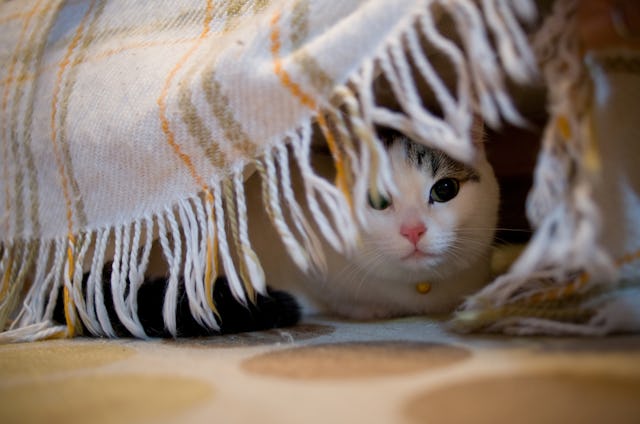Why Is My Cat Hiding All The Time, & When Should I Worry? A Veterinarian Explains
Aka: How do I tempt my cat out of its beloved and deeply inconvenient hiding place?

Every cat has their beloved hiding place. If you're a cat parent, you know this to be true. My cat Olive's favorite spot is beneath my queen-sized bed. She likes to hide among my clothing organizers, boxes of old photographs, and Christmas tree. It's a fairly innocuous spot except when I need to retrieve her, like when my building's fire alarm went off. Twice. In one night. Then, all of a sudden, her little hiding spot becomes Fort Knox, and it is almost impossible for me to grab her at a moment's notice.
My fellow cat parents can probably relate. So, how do you tempt your kitty out of their deeply inconvenient hiding place? First, as Dr. Paula Simons, veterinary advisor at DogNerdz.com, points out, it's important to remember that cats hide for a reason.
"While cats are perfect little predators, their small size makes them susceptible to becoming prey for larger animals, such as coyotes. For this reason, a cat's natural instinct is to hide when it is feeling nervous, unsafe, or unwell," she tells Scary Mommy. "Cats may also try to find secure places to sleep where they are out of reach from potential dangers."
Bearing that in mind, maybe the better question is—with the exception of emergencies—should you tempt your cat out of its hiding place? And what do we need to understand about our kitties and their reasons for hiding? See Simons’ answers below.
What techniques could tempt your cat out of its hiding place?
As Simons mentioned above, cats are generally hiding for a reason. Whether out of fear, illness, or just wanting to feel safe, "they're doing this to protect themselves and should never be forced out of hiding," she says. "Doing so will cause cats to become more reclusive and fearful or even to potentially bite or scratch."
Before tempting your cat out of its favorite hiding spot, Simons recommends trying to understand why it is happening and changing the environment, if possible, to alleviate anxiety.
"This may mean turning down loud sounds, putting the dog into another room, or asking roommates to be less rowdy," she says. "Once the environment feels more welcoming, you can gently call their name to encourage them to come out. If this doesn't work, food or treats are always tempting for food-motivated kitties. Shake a treat bag or their favorite bowl and see if they come out."
What types of places are good and not-so-good for cats to hide?
Cats need safe places to hide, which generally include spots free of dangers and where the kitty won't accidentally be locked away or become stuck.
According to Simons, safe places include cat trees, boxes, under the bed, in open closets, under the couch, and similar spots. Unsafe places include within the stuffing of a mattress, under sinks, closets or drawers that can be closed, in holes within the drywall or ceiling, or anywhere containing unsafe items that can injure cats, like a garage.
When is it a cause for concern when cats have hiding places?
While all cats tend to hide for one reason or another, Simons says any cat experiencing a sudden change in behavior that is atypical for them should raise an alarm.
"While I expect a new rescue cat to want to hide for a few days, a previously integrated, social cat should not suddenly become reclusive without major change within the home," she says. "Any cat that is showing signs of illness such as not eating or drinking, vomiting, lethargy, or pain needs to be evaluated by a veterinarian ASAP. Hiding is often the first sign of illness."